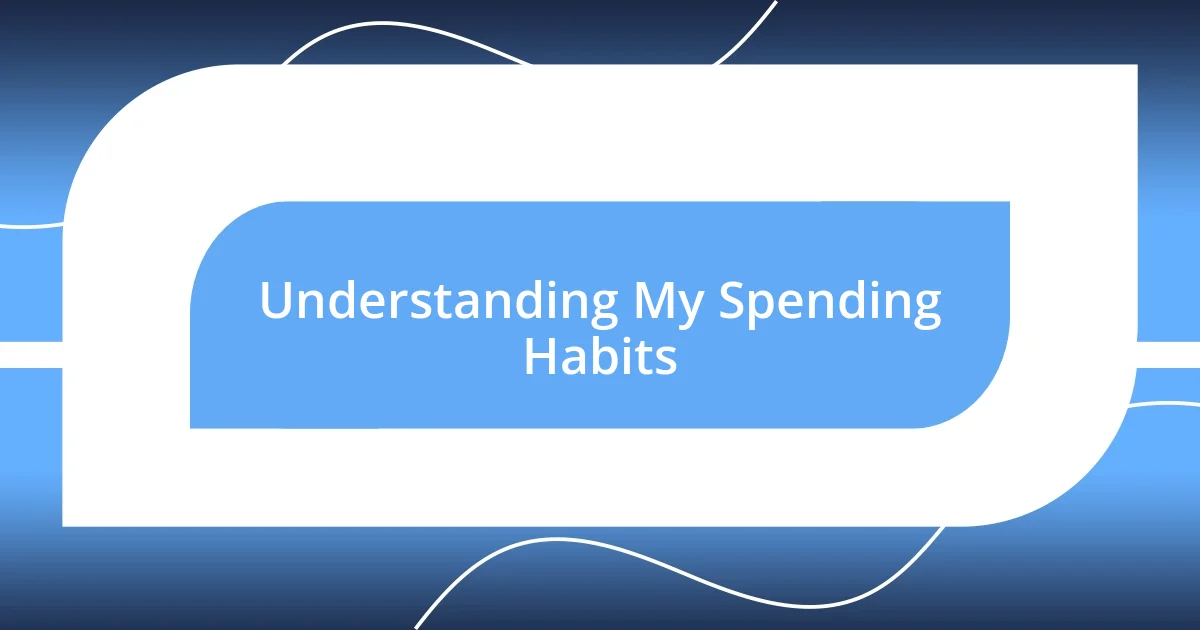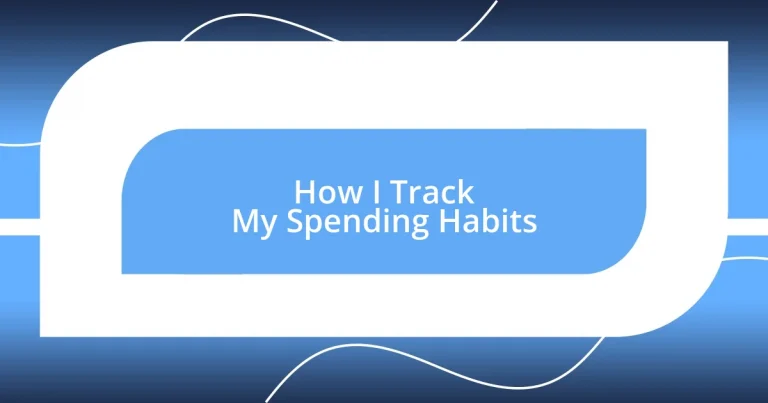Key takeaways:
- Recognizing emotional triggers and impulsive spending led to a proactive approach in tracking and understanding spending habits.
- Establishing a structured budget and utilizing tracking tools, like mobile apps, provided clarity and accountability in financial management.
- Regularly reviewing spending trends and setting limits fostered intentionality in purchases, encouraging a focus on quality over quantity.

Understanding My Spending Habits
Understanding my spending habits has been quite the journey. I remember when I first noticed I was splurging on takeout every Friday night without really thinking about it. Who doesn’t love to treat themselves after a long week? Yet, I realized that these small, seemingly harmless purchases were adding up more than I expected.
Now, when I reflect on my spending patterns, I often find myself asking: what drives my impulses? There are days when boredom or stress pushes me to click “buy” without a second thought. Looking back, I’ve had moments where guilt washed over me after a spontaneous purchase, reminding me that emotional spending isn’t just a concept; it’s a reality I navigate every day.
Tracking my expenses has opened my eyes to these habits, revealing trends I never acknowledged before. For instance, I noticed that I typically spend less on weekends, which makes sense since I’m often out with friends, making memories rather than mindless purchases. This insight has empowered me to redesign my weekend plans—now, I prioritize experiences, enriching my life far beyond the fleeting joy of new items.

Setting Up a Budget Plan
Creating a budget plan feels like crafting a roadmap for financial success—something I didn’t take seriously until a few years ago. I remember sitting down one Saturday morning, surrounded by coffee cups and sticky notes, trying to figure out how to balance fun with responsibility. It was a revelation to see my income and expenses laid out clearly; it made me realize how many unnecessary subscriptions were quietly draining my bank account each month.
When it comes to setting up a budget plan, I’ve found a simple format works best for me. Here’s how I break it down:
- Identify Your Income: List all sources of income, including side gigs and passive earnings.
- Categorize Expenses: Separate them into fixed (like rent or mortgage) and variable (like groceries and entertainment).
- Set Spending Limits: Decide how much you want to allocate for each category. I often set lower limits for discretionary spending.
- Track and Adjust: Use budgeting apps or spreadsheets to track your spending against your budget; adjust as needed.
- Review Monthly: I always take time at the end of the month to reflect on my spending and see what worked and what didn’t—this habit has been transformative.
By taking these steps, I feel more empowered and in control of my financial future. When I see my savings grow, I can’t help but smile, knowing I made a commitment to my goals.

Choosing the Right Tracking Tools
Choosing the right tools for tracking spending can feel overwhelming, but I’ve learned a few tricks along the way. In my experience, the best tool is the one that aligns with my lifestyle and preferences. For example, when I first tried a budgeting app, I was initially frustrated by the setup, as I was accustomed to jotting down expenses in a simple notebook. However, once I became familiar with the digital platform, I found it incredibly efficient and insightful.
When evaluating different options, I always consider how accessible and user-friendly each tool is. I recall using a spreadsheet for a while—while it was customizable, it wasn’t as engaging as my current app. The key is to find a balance between functionality and enjoyment so that tracking spending becomes a habit rather than a chore.
It’s essential to also think about any extra features you might benefit from. Some tools come equipped with reminders and analysis graphs that have made a difference in how I analyze my spending. I’ve often appreciated apps that provide categories for expenses, allowing me to visualize where my money goes—something I never realized was so enlightening until I saw my food expenses displayed in a bright, eye-catching pie chart!
| Tracking Tool | Pros |
|---|---|
| Mobile Apps | User-friendly, often includes budgeting features, allows for real-time updates |
| Spreadsheets | Highly customizable, control over formulas, can be detailed |
| Financial Software | Integrated bank accounts, detailed reports, investment tracking available |
| Physical Notebooks | Tactile and personal, can include sketches or notes, minimal tech requirement |

Utilizing Mobile Apps for Tracking
Using mobile apps to track my spending has truly transformed the way I manage my finances. I remember when I first downloaded a budgeting app; I felt a mix of excitement and skepticism. Could an app really help me stay accountable? To my surprise, it did. The immediate feedback about my spending habits allowed me to adjust my behavior in real time. I often found myself checking the app before making impulse purchases, which has ultimately saved me a good chunk of change.
One feature I particularly love is the expense categorization. Watching my monthly dining-out budget exceed its limit was a wake-up call. Who knew that those quick coffee runs and takeout lunches added up so quickly? With just a tap on my phone, I can see exactly where my money is going, which has prompted me to experiment with meal prepping. I’ll admit—seeing the numbers laid out in front of me creates a sense of urgency I didn’t have before. Have you ever experienced that moment of clarity when a simple chart reveals what you thought were harmless habits? It’s quite eye-opening.
Another great aspect of these apps is the reminder function. I used to forget about upcoming bills, leading to late fees and unnecessary stress. Now, my app notifies me of impending payments, which gives me peace of mind. Adopting this habit has made me not only more organized but also more confident in my financial decisions. Who wouldn’t want that kind of clarity in their financial journey? Tracking spending through mobile apps has become a pivotal part of my day-to-day, and I encourage anyone hesitant about it to give it a try. You might find that you enjoy it more than you think!

Categorizing My Expenses Effectively
When categorizing my expenses, I’ve discovered that clarity is vital. Initially, I grouped everything into broad categories like “Food” and “Bills.” But over time, breaking it down into subcategories—like “Groceries,” “Dining Out,” and “Utilities”—has been a game-changer. It’s thrilling to dive deep into my spending patterns and uncover trends I hadn’t noticed before, like how brunch outings were slowly draining my budget.
One particular month stands out—I categorized my entertainment expenses and was hit with a surprising realization. I had allocated a generous amount for streaming services, but my impulse purchases on movie night snacks were sneaking up on me. Seeing that distinction made me reflect: am I really getting value from those snacks versus the shows I love? Sometimes, those insights fuel a strong desire to make better financial choices moving forward.
Moreover, I’ve found it useful to color-code my categories in my app. Visualizations can elicit emotions—for example, seeing my “Savings” category in green gives me a jolt of optimism, while a red “Overspending” bar can stir a bit of anxiety. It’s like a little reminder that I’m in control of my finances. Do you ever wish you could pinpoint those trends more effectively? Trust me; effective categorization can lead to empowering revelations that reshape your everyday spending habits.

Reviewing and Analyzing Trends
It’s fascinating to take a step back and truly review the data I’ve collected over time. I remember the first time I sat down with my app to analyze my yearly spending trends—it felt almost like opening a time capsule. I discovered patterns I had completely overlooked, like how during certain months, my entertainment spending significantly spiked. Have you ever paused to consider if specific events or seasons trigger spending surges for you? For me, it became evident that summer vacations were contributing to my habit of indulging in experiences I didn’t really budget for.
When I reflect on these trends, it’s not just about the dollars and cents; it’s about understanding my emotional triggers too. For example, I realized that when I feel stressed from work, I tend to treat myself to more “retail therapy” than I’d like to admit. Then there was a shocking month where I overspent on online shopping by 60%. That figure still makes me a bit uncomfortable, but it sparked a commitment to seek joy in alternative ways. Could acknowledging these emotional ties help you make more mindful choices? For me, the answer was a resounding yes.
I often revisit my spending analysis to stay aligned with my financial goals. A crucial part of this journey has been celebrating small victories, like a month where I managed to save more than I spent. I distinctly recall the pride I felt when I compared my last year’s spending with this year’s. Seeing those numbers in black and white reminded me that transformation is possible with consistent effort. Doesn’t it feel rewarding when you can visualize your efforts paying off? Tracking trends not only keeps me accountable but also sets the stage for continuous growth and improvement in my financial habits.

Adjusting My Spending Behavior
Adjusting my spending behavior has been a reflective journey. One day, I looked at my closet full of clothes and realized that many of them still had tags on them. That moment struck me—was I truly purchasing items I needed, or was I merely following a trend? It turns out that taking a moment to assess my wardrobe led me to rethink my shopping habits and focus on quality over quantity.
Another powerful moment came when I decided to set a monthly spending limit for discretionary purchases. The first month was challenging. I remember feeling anxious every time I hesitated before clicking “buy” on an online shopping site. But that discomfort quickly became enlightening. Refraining from impulsive buys helped me appreciate the things I truly loved, and I discovered how much joy there is in waiting and saving up for something special. Do you find yourself buying things on a whim? Trust me, creating those boundaries can shift your mindset significantly.
To further bolster my resolve, I created a vision board of financial goals. This personalized visual reminder makes my aspirations tangible and helps me stay focused. Every time I walk past it, I feel a rush of motivation. Have you ever thought about how visualizing your financial dreams could spur you on? For me, it changes the game—it’s not just about cutting back; it’s about feeling empowered and excited to reach those goals. Adjusting my spending behavior isn’t about deprivation but rather an opportunity for enrichment and intentionality in my financial life.














